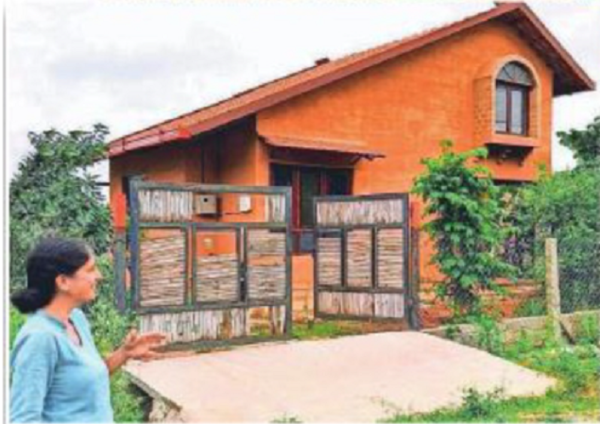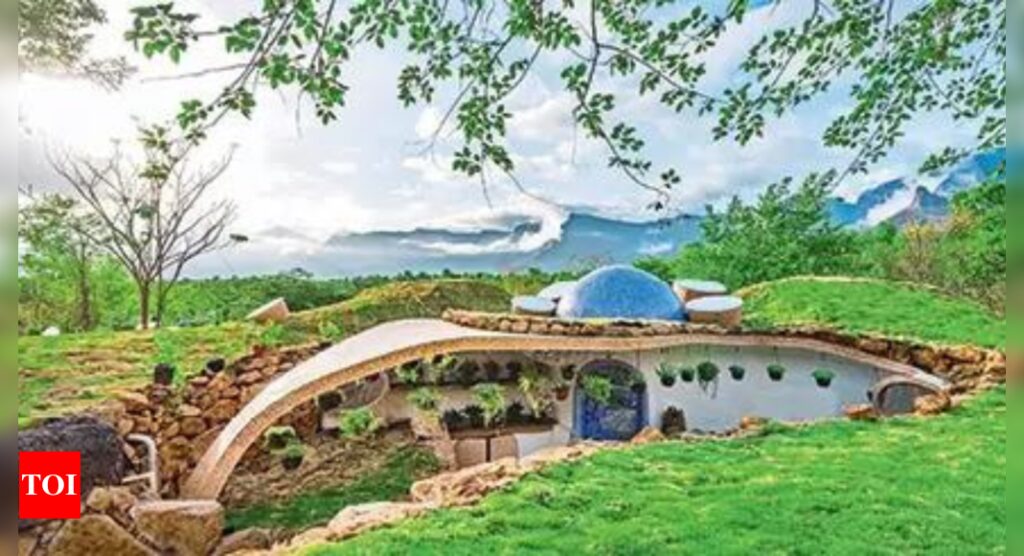[ad_1]
One of the hallmarks of the legendary British-born Indian architect Laurie Baker was his use of local, cheap and renewable materials like mud bricks made from local clay. But then came the cement and steel era, and sustainable materials were forgotten. But now, earth or mud homes are finding favour again with those who want to go back to rustic living with a low carbon footprint.
One and a half years ago, Marie and her husband Dhiraj Chaudhari ditched city life to embrace a more sustainable lifestyle. With the help of architect Satyendra Bhagat, they built their dream home from locally sourced natural materials in their ancestral town of Mandu in Madhya Pradesh.
“Our house is made with mud, lime plaster and bamboo. It is designed in such a way that it is insulated from the heat and we get cool breeze throughout the day,” says Marie, who originally hails from France. The couple plans to lease out two bedrooms and make it a homestay. Perched at an altitude of 2,000 feet, Mandu attracts many tourists between October and March.
In Bengaluru, Reva and Ranjan Malik have been living in a mud house for the last three years. Reva says while the two had lived in cities all their lives, she would remember her childhood in the mountains and find herself missing the slow, earthy life that came with it. She says, “We would talk to our children about sustainability and water scarcity but what were we doing as a family?” The family’s mud home has made their sustainable and slow living dreams a reality, rooted in their belief that they do not wish to take too much from nature, and give back whatever they do take.
“We have an earth home in Karjat which may take about six months more to complete, but it is not exactly small. It has verandahs and high ceilings with arches. We hope to move in once it’s ready,” says Mumbai resident Lata Vasvani, director of Engage Learning.
Homing in for a holiday
Architects say that many other clients wish to build these homes as second homes or weekend homes.
A quick online search revealed that there are over 200 ‘earth home’ listings on Airbnb in India. Other booking portals like SaffronStays are also seeing good demand in bookings for mud homes. “At the moment we have a mix of mud homes in Maharashtra and Himachal Pradesh that are listed,” says Deven Parulekar, founder of SaffronStays. One of the sought-after properties on their site is an earth home in Murbad, Maharashtra. It’s got unique architecture and a pool.
“We built this dream home for ourselves and then thought of sharing this experience with others. We are seeing an average occupancy of 80% across seasons and have an average tariff of Rs 40,000 per night. I would call the home a sustainable earth-sheltered home because the roof is completely made with earth as the cover,” says Sanjam Lalwani, owner of AsanjA in Murbad.
For the Maliks, the desire to live a sustainable life led them to a mud house. They considered a bamboo house as well, but their visits to nearby villages endeared them to the idea of living in a home that feels part of nature, rather than in opposition to it. With the help of Bengaluru-based organisation Gramavidya, which focuses on mud houses, they built their house, which has a robust rainwater harvesting system, solar panels and composting pits.

Takes time, money and love
“There is a misconception that earth homes are cheaper to build than regular homes, but they are extremely labour intensive and the money that one saves in material cost is spent on labour,” says architect Anujna Nutan.
Not just money, it also takes time. “The process of building a low-cost sustainable home can be time-consuming and it requires patience from both owners and artisans. The other challenge that we face is that artisans have forgotten traditional techniques of building and finding the right labour can be challenging,” says architect Satyendra Bhagat.
Aastha Malik, host of Elements Cottages in Kullu, says they hired local villagers from Kullu.“Our home has been built using only mud plaster, wood and stone. We initially built one home and now we have constructed 12 rooms that are offered to tourists,” she says. In terms of maintenance, she is aware that the mud plaster needs to be touched up once every five years.
Reva Malik compares maintaining their Bengaluru mud house to taking care of one’s body. “Just like your body needs regular attention, so does this house. If you leave it for too long, nature claims it. So, creepers may grow on the walls and there can be squirrels and anthills,” she says, adding that as long as they draw boundaries around the house and clean regularly, this is not a problem.
— Inputs by Ketaki Desai
[ad_2]
Source link










More Stories
Congress replaces Kamal Nath, names an OBC as Madhya Pradesh chief | India News
Fire breaks out in ITBP camp in Srinagar; none hurt | India News
Parliament Security: Co-villagers give clean chit to Lalit Jha, parents to move court | India News